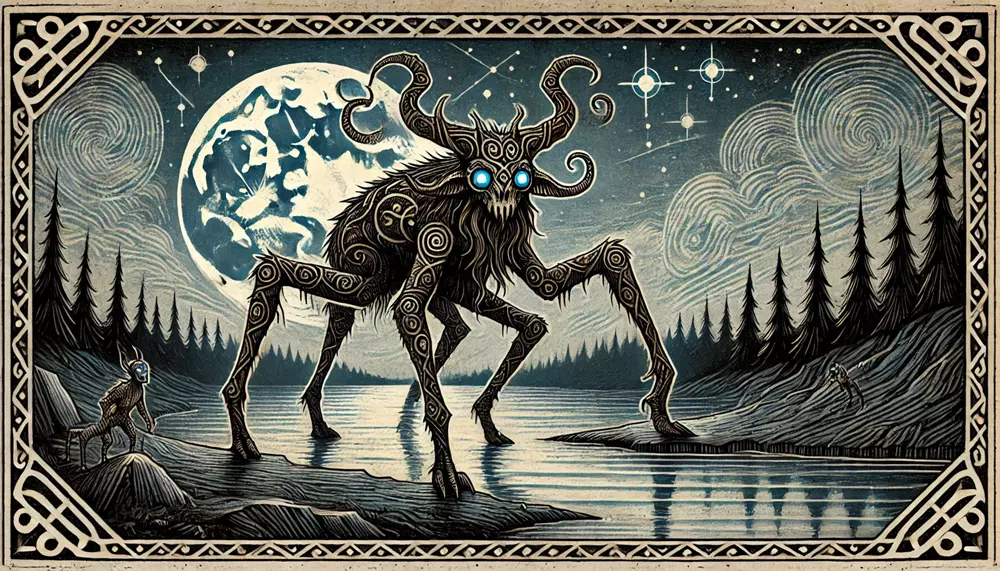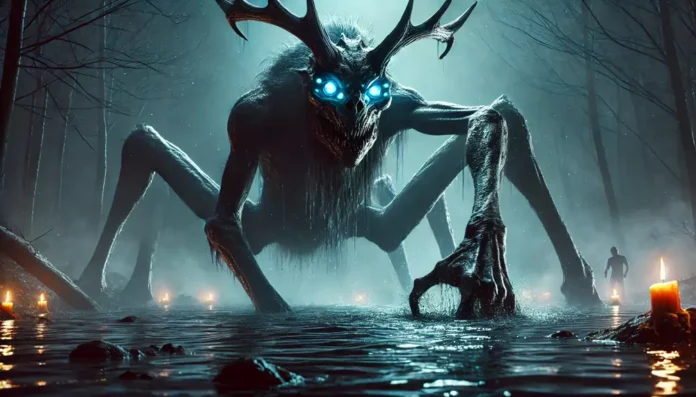Introduction
The Bukavac is a six-legged monster from Serbian folklore, often depicted as an amphibious creature lurking in swamps and rivers. Known for its terrifying roar and its tendency to attack at night, the Bukavac embodies the fear of mysterious beasts hiding in the dark.
History/Origin
The Bukavac emerges from Serbian folklore, a creature deeply embedded in local beliefs about the dangers lurking near water. Many believed the Bukavac originated as a warning symbol against approaching swamps and still waters at night. The myth likely took shape during the medieval period, when tales of unknown dangers became entwined with everyday life, spreading across small rural communities and passing from generation to generation. The Bukavac is thought to dwell primarily around the Vojvodina region of Serbia, although tales of similar creatures can be found throughout the Balkans, suggesting a broader cultural fascination with monstrous beings associated with water and darkness.
“Fear the creature with six legs and a roar that shakes the night, for it lurks where darkness meets the water.”
Name Meaning
The name “Bukavac” is derived from the Serbian word “buka,” which translates to “noise” or “uproar.” This title is a reflection of the creature’s defining feature: a loud, thunderous roar. It’s said that the Bukavac emits a terrifying sound that can freeze anyone in their tracks, often foreshadowing an attack. This loud cry symbolizes the chaotic and untamed forces of nature, reminding people of their vulnerability to the unknown.

Background Story
One of the most well-known tales about the Bukavac involves a group of villagers who dared to venture out to the river at night. They heard a loud, bone-chilling scream that echoed through the forest. Terrified, they retreated, but one brave villager stayed to investigate. As he approached the water’s edge, he saw the Bukavac’s glowing eyes and monstrous form emerge, its roar sending ripples across the river’s surface. He barely escaped, and from then on, the villagers avoided the river at night, believing that the Bukavac guarded its domain fiercely.
“A sound like thunder, a creature that defies nature, this is Bukavac, lord of the river shadows.”
Cultural Impact
The Bukavac served as a practical warning against venturing too close to dangerous bodies of water, especially at night. Its story highlighted the importance of respecting nature’s boundaries, particularly in rural Serbian communities reliant on rivers and lakes for fishing and sustenance. Over time, the Bukavac became an emblem of the fear of wild, untamed places. Its tale was retold by parents to keep children safe from wandering near rivers and by villagers who encountered eerie sounds during the dark hours.
Similar Beasts
The Bukavac has parallels with other mythological water monsters across various cultures. In Slavic mythology, the Vodnik is a water spirit who also guards rivers and ponds. The Irish Kelpie, a shape-shifting water horse, is known for luring people into water to drown them. These creatures reflect a universal mythological archetype: beings that symbolize the danger of water and the unknown that lies beneath its surface.
Religion/Ritual
The Bukavac legend, while not directly tied to formal religious practices, became part of local Serbian superstitions. Villagers would avoid the river banks at night and perform small rituals to protect themselves from water spirits, like leaving a small offering near water sources to appease the spirit. Certain communities believed that invoking the name of St. John, a figure who is believed to protect against spirits and devils in Serbian Orthodoxy, could deter the Bukavac and ensure safe passage by the river.
“Cry out for St. John to shield you, lest the night’s creature drag you to the water’s depths.”
Scientific or Rational Explanations
In contemporary times, some anthropologists and folklorists suggest that the Bukavac myth was likely inspired by the natural sounds and occurrences around Serbia’s riverbanks. Frogs, birds, and other nocturnal creatures often produce loud and eerie sounds near water, especially during the spring and summer months. Additionally, the presence of six legs in the description could have been an exaggeration, with local wildlife misinterpreted or enhanced by folklore. The Bukavac’s reputation as a monstrous amphibious creature may have been a way to rationalize and protect against mysterious, potentially dangerous areas.Water Devil, Water Monster
Modern Cultural References (5-19 examples/references)
Books: In Serbian folklore anthologies, the Bukavac often appears as a featured creature in the “Beasts of the Balkans” collections, introducing new readers to its eerie tale.
Films: Serbian cinema has produced a few horror films inspired by the Bukavac legend, incorporating its chilling roar and monstrous form.
Games: The Bukavac has appeared as a creature in folklore-based games, particularly in the indie horror genre, where players must escape from its roar.
TV Shows: Episodes on Serbian folklore in local television series often highlight the Bukavac as an example of traditional ghost stories.
Music: Some Serbian folk bands have referenced the Bukavac in their lyrics, using its story as a metaphor for overcoming fear.
Comics: Illustrated stories about Serbian legends, including the Bukavac, have gained popularity, especially among younger readers interested in folk horror.
Art: Artists in Serbia often depict the Bukavac in paintings and sculptures, exploring its monstrous form in both traditional and modern interpretations.
Folklore Studies: The Bukavac is studied in academic settings, especially in the Balkans, as an example of Slavic water-related folklore.
Festivals: Serbian folklore festivals sometimes feature Bukavac-inspired costumes, allowing people to bring this creature to life.
Online Folklore Communities: The Bukavac has a presence in forums and social media, where it’s discussed as a fascinating and eerie figure in Serbian folklore.

Conclusion
The Bukavac remains one of Serbia’s most enigmatic creatures, symbolizing the timeless human fear of what lurks in dark, uncharted places. As a myth, it has served not only as a cautionary tale but also as a testament to the rich imagination of Serbian folklore. While rational explanations may point to natural sounds and wild animals, the Bukavac’s story endures, reminding people of the thrill and dread of facing the unknown. Its story has transcended generations, rooted in Serbia’s cultural landscape, where it continues to inspire modern interpretations in art, media, and literature. Whether seen as a protective warning or an entertaining legend, the Bukavac captivates those who hear its roar, urging respect for the mysteries of nature.




